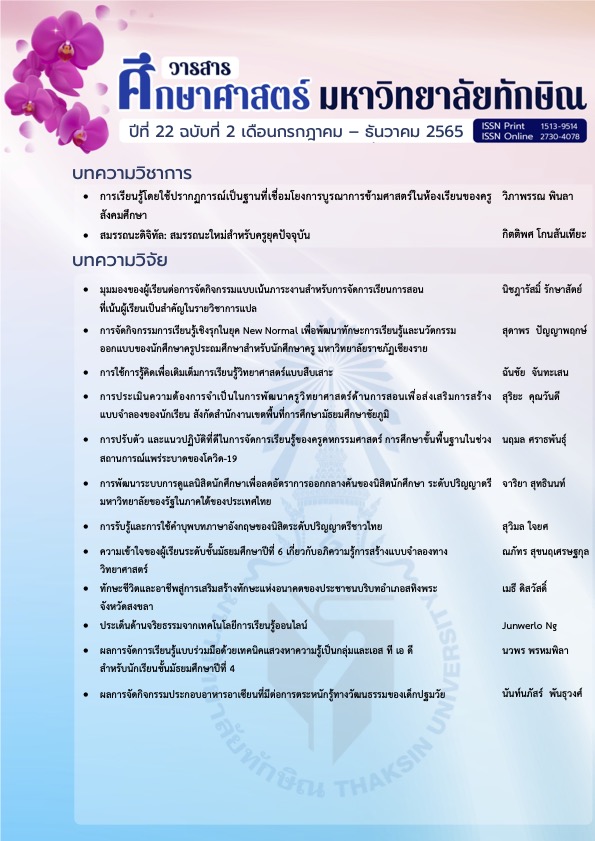การรับรู้และการใช้คำบุพบทภาษาอังกฤษของนิสิตระดับปริญญาตรีชาวไทย
Main Article Content
บทคัดย่อ
งานวิจัยนี้มีวัตถุประสงค์เพื่อศึกษาการรับรู้และการใช้คำบุพบทภาษาอังกฤษทั้งคำบุพบทอิสระและคำบุพบทไม่อิสระของนิสิตระดับปริญญาตรีชาวไทย กลุ่มตัวอย่างเป็นนิสิตที่เรียนวิชาภาษาอังกฤษเป็นวิชาโท จำนวน 50 คน จากมหาวิทยาลัยแห่งหนึ่งในประเทศไทย เครื่องมือวิจัยที่ใช้ในการเก็บข้อมูล คือ แบบทดสอบการรับรู้ (การตัดสินเกี่ยวกับไวยากรณ์) และการใช้คำบุพบทภาษาอังกฤษ (การเขียน) ทั้งคำบุพบทอิสระและคำบุพบทไม่อิสระ โดยเครื่องมือวิจัยที่ใช้ได้นำมาจากเครื่องมือวิจัยของเรืองจรูญ (2558) ข้อสอบแต่ละข้อในแบบทดสอบทั้ง 2 ชุดเป็นข้อสอบแบบคู่ขนานกัน งานวิจัยนี้ได้ใช้การทดสอบความแตกต่างค่าเฉลี่ยของกลุ่มตัวอย่าง 2 กลุ่มไม่อิสระ (Paired Sample T-test) ในการเปรียบเทียบคะแนนการรับรู้และการใช้คำบุพบทภาษาอังกฤษทั้งคำบุพบทอิสระและคำบุพบทไม่อิสระของนิสิตกลุ่มตัวอย่าง ผลการวิจัยแสดงให้เห็นว่า นิสิตได้คะแนนการรับรู้คำบุพบทภาษาอังกฤษสูงกว่าคะแนนการใช้คำบุพบทภาษาอังกฤษ นอกจากนี้นิสิตยังได้คะแนนการรับรู้คำบุพบทและการใช้คำบุพบทอิสระสูงกว่าคำบุพบทไม่อิสระอีกด้วย แต่อย่างไรก็ตามคะแนนที่ได้ไม่สูงมาก ซึ่งแสดงให้เห็นว่านิสิตมีปัญหาในการตัดสินและการเลือกใช้คำบุพบทภาษาอังกฤษคำทั้งคำบุพบทอิสระและคำบุพบทไม่อิสระให้ถูกต้อง
Article Details

อนุญาตภายใต้เงื่อนไข Creative Commons Attribution-NonCommercial-NoDerivatives 4.0 International License.
ในกรณีที่กองบรรณาธิการ หรือผู้เชี่ยวชาญ ซึ่งได้รับเชิญให้เป็นผู้ตรวจบทความวิจัย หรือ บทความทางวิชาการมีความเห็นว่าควรแก้ไขความบกพร่อง ทางกองบรรณาธิการจะส่งต้นฉบับให้ ผู้เขียนพิจารณาจัดการแก้ไขให้เหมาะสมก่อนที่จะลงพิมพ์ ทั้งนี้ กองบรรณาธิการจะยึดถือความคิด เห็นของผู้เชี่ยวชาญเป็นเกณฑ์
เอกสารอ้างอิง
Al Khotaba, E. (2013). Errors in the use of prepositions and adverb particles by Arab ESL speakers: Performance analysis perspective. International Journal of Linguistics, 5(1), 273-282.
Atmaca, C. (2016). Error analysis of Turkish EFL learners: A case study. Social and Behavioral Sciences, 232, 234-241.
Castro, M. C. S. A. (2013). An analysis of prepositional errors of college students. Proceedings of the 3rd International Conference on Foreign Language Learning and Teaching (pp. 97-108). Pathum Thani: Thammasat University Press.
Catalan, R. J. (1996). Frequency and variability in errors in the use of English prepositions. Miscelanea: A Journal of English and American Studies, 17, 171-188.
Dalgish, G. (1985). Computer-assisted ESL research and courseware development. Computers and Composition, 2(4), 45-62.
Diab, N. (1997). The transfer of Arabic in the English writings of Lebanese students. The ESPecialist, 18(1), 71-83.
Felix, S. (1991). Universal grammar in L2 acquisition: Some thoughts on Schachter’s incompleteness hypothesis. In L., Eubank, L., Selinker, & M. S., Smith (Eds.), The Current State of Interlanguage (pp. 139-152). Amsterdam: John Benjamins.
Finney, A. M. (2005). Perception of errors in second language syntax: Acquisition or processing difficulties? In J. Cohen, K. T. McAlister, K. Rolstad, & J. MacSwan (Eds.), Proceedings of the 4th international symposium on bilingualism (pp. 751-767). Somerville, MA: CascadillaPress.
Kampookaew, P. (2020). An analysis of grammatical errors made by Thai EFL university students in an EAP writing class: Issues and recommendations. rEFLections, 27(2), 246-273.
Kurk, G., & Atay, D. (2007). Students’ writing apprehension. Journal of Theory and Practice in Education, 3(1), 12-23.
Latif, M. A. (2007). The factors accounting for the Egyptian EFL university students’ negative writing affect. Language & Linguistics, 9(1), 57-82.
Loke, D. L., Alil, J. & Anthony, N. N. Z. (2013). A corpus-based study on the use of preposition of time ‘on’ and ‘at’ in argumentative essays of form 4 and form 5 Malaysian students. English Language Teaching, 6(9), 128-135.
Phoocharoensil, S., Moore, B., Gampper, C., Geerson, E. B., Chaturongakul, P., Sutharoj, S., & Carlon, W. T. (2016). Grammatical and lexical errors in low-proficiency Thai graduate students’ writing. Language Education and Acquisition Research Network (LEARN) Journal, 9(1), 11-24.
Promsupa, P. (2016). An analysis of grammatical errors in English writing of Thai university students (Master’s thesis, Burapha University, Chonburi). Retrieved from http://lib.buu.ac.th/
Tunaz, M., Muyan, E., & Muratoglu, N. (2016). A corpus-based study on the preposition error types in Turkish EFL learners' essays. International Peer-Reviewed Journal of Humanities and Academic Science, 17, 1-16.
Ruangjaroon, S. (2015). Perception and production of Thai learners on English prepositions. English Language Teaching, 8(1), 71-82.
Sermsook, K., Liamnimitr, J., & Pochakorn, R. (2017). An analysis of errors in written English sentences: A case study of Thai EFL students. English Language Teaching, 10(3), 101-110.
Seyitkuliyev, D., Keyuravong, S., & Bunsom, T. (2020). Investigation of grammatical errors committed by Turkmen learners of English. Journal of Humanities and Social Sciences University of Phayao, 8(1), 96-117.
Sumonsriworakun, P., & Pongpairoj, N. (2017). Systematicity of L1 Thai learners’ English interlanguage of dependent prepositions. Indonesian Journal of Applied Linguistics, 6(2), 246-259.
Suvarnamani, S. (2017). A study of grammatical and lexical errors in descriptive writing of first year arts students at Silapakorn University. Silapakorn University Journal of Social Sciences, Humanities, and Arts, 17(2), 239-264.
Swan, M. (2005). Practical English usage (3rd ed.). Oxford, England: Oxford University Press.
Thong-Iam, N. (2016). English into Thai translation errors of English prepositions and prepositional phrases of Thai undergraduates. Journal of RMUTTO (Humanities and Social Sciences, 5 (2), 1-10.
Thumawongsa, T. (2018). L1 transfer on Thai EFL learners' utilization of prepositions: A corpus-based analysis. Journal of Community Development Research (Humanities and Social Sciences), 11(1), 35-47
Tsimpli, I., & Roussou, A. (1991). Parameter-Resetting in L2? UCL Working Paper in Linguistics, 3, 149- 169.
Yaari, S. A. (2013). The Problem of translating the prepositions at, in, and on into Arabic: An applied linguistic approach. Journal for the Study of English Linguistics, 1(2), 256-273.


